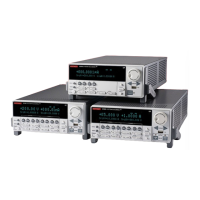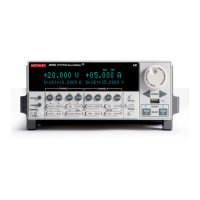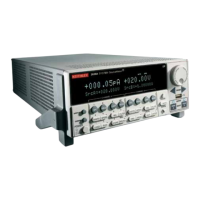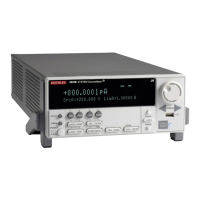10-24 Return to Section Topics 2600AS-901-01 Rev. B / September 2008
Section 10: Triggering Series 2600A System SourceMeter® Instruments Reference Manual
Using the assert() function to generate trigger events
Certain trigger objects can be used to generate output triggers on demand. These trigger objects
are the digital I/O lines, TSPLink synchronization lines and the LAN.
To generate an output trigger, use the assert function of the trigger object as shown in the
following example:
-- Generate a falling-edge trigger on digital I/O line 3.
digio.trigger[3].mode = digio.TRIG_FALLING
digio.trigger[3].assert()
-- Generate a rising edge trigger on TSP-Link sync line 1.
tsplink.trigger[1].mode = tsplink.TRIG_RISINGM
tsplink.trigger[1].assert()
-- Generate a LAN trigger on LAN pseudo line 6.
lan.trigger[6].mode = lan.TRIG_EITHER
lan.trigger[6].assert()
Using the release() function of the hardware lines
Use the release() function to allow the hardware line to output another external trigger when
the pulse width is set to 0.
Setting the pulse width to 0 results in an indefinite length pulse when the assert()function is
used to output an external trigger. The release() function must be used to release the line in
order to output another external trigger.
The release() function can also be used to release latched input triggers when the hardware
line mode is set to Synchronous. In Synchronous mode, the receipt of a falling edge trigger latches
the line low. The release() function releases this line high in preparation for another input
trigger.
Example:
-- Set digio line 1 to output a indefinite external trigger.
digio.trigger[1].mode = digio.TRIG_FALLING
digio.trigger[1].pulsewidth = 0
digio.trigger[1].assert()
-- Release digio line 1.
digio.trigger[1].release()
-- Output another external trigger.
digio.trigger[1].assert()
Using the set() function to bypass SMU event detectors
The set() function is useful whenever you want the SMU to continue operation without waiting
for a programmed trigger event.
There is a set() function for each SMU event detector. When called, the function immediately
satisfies the event detector, allowing the SMU to continue through the trigger model.
A common example of when the set() function can be used is when you want the SMU to
immediately perform an action the first time through the trigger model even if a programmed
trigger event does not occur. The set() function can be used to start actions on the SMU in case
of a missed trigger event.

